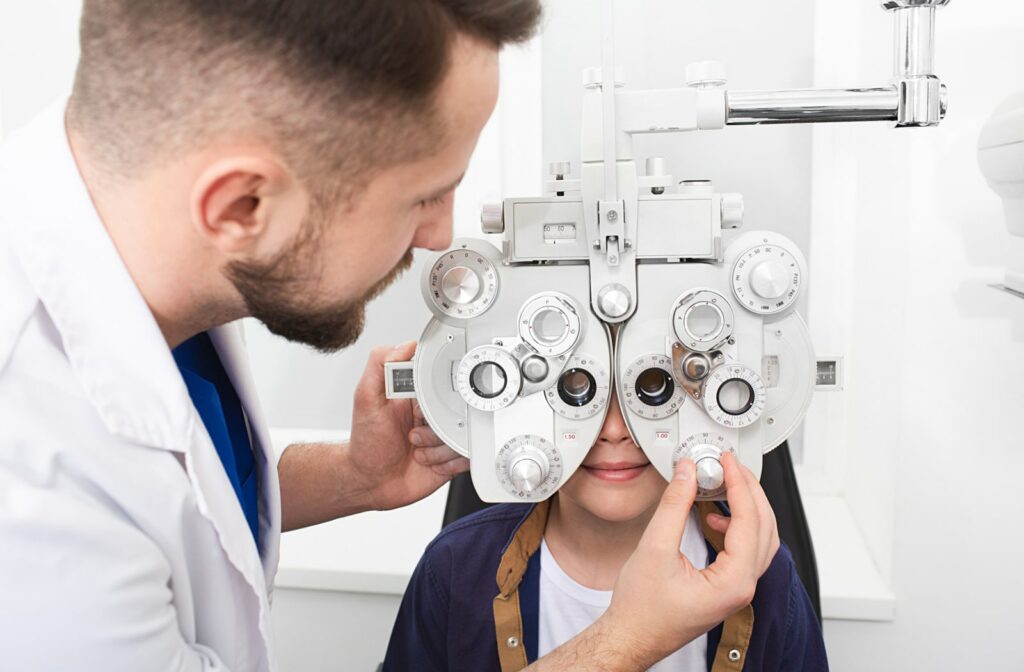As parents, it is our responsibility to ensure our children get the right start with their health. One of the most critical aspects of a child’s health is their eyesight.
Children don’t always recognize or understand when they have a vision problem, which makes regular eye exams crucial in detecting issues early.
When you take your little ones for an eye exam, the eye doctor will check their eye health and run tests to make sure they’re hitting all their visual milestones. These exams are key in catching any problems early, so they can be treated right away and have minimal impact on your child’s development and overall quality of life.
Keeping their eyes healthy and making sure they can see clearly is essential as they grow. By getting regular check-ups, you’ll be able to stay on top of any changes in their vision and take proactive steps to protect their eyes.
The Importance of Children’s Eye Exams
Vision plays a crucial role in your child’s overall development. It impacts their academic performance, social interactions, and even sports activities. 80% of what a child learns is visual. So, without good vision, children may struggle with reading, writing, and understanding visual information. They might have difficulty seeing the board at school or recognizing their friends’ faces during playtime.
Children’s eyes are always growing and changing. We need to assess their eyes and visual skills during an eye exam to make sure they’re on the right track. Some of the skills we measure include:
- Eye alignment
- Eye movement control
- Focusing power
- Central vision
- Peripheral vision
- Colour perception
- Depth awareness
Frequency of Children’s Eye Exams
Regular monitoring of your child’s vision is necessary as their eyes continue to develop throughout childhood. Your doctor may recommend:
- Their first eye exam between 6 and 9 months
- Their second eye exam between 2 and 5 years
- Yearly eye exams between 6 and 19 years
They might also recommend more frequent eye exams based on certain conditions.
The Important Steps of Children’s Eye Exams
When children are born, their eyes are underdeveloped. Meaning as they grow, their eyes grow with them. The visual skills they develop during childhood will support them throughout their lives. This constant change also means that vision problems can crop without notice, making regular eye exams vital for your child’s overall development.
Knowing what happens during a children’s eye exam can help you prepare your child for the visit so it’s less intimidating.
The eye exam itself is simple and designed to be child-friendly. Your child’s eye doctor will explain the eye testing process and the tools they will use during the process to help your little one feel comfortable before beginning.
Gathering Essential Information
The first step in a children’s eye exam involves collecting vital information about your child’s overall health and family history of eye conditions. The initial assessment sets the foundation for the personalized exam, allowing the eye doctor to tailor their approach based on your child’s needs.
Visual Acuity Testing
Visual acuity testing, commonly known as the eye chart test, is a familiar scene in eye examinations. During this test, the eye doctor will assess your child’s ability to see objects or letters at various distances.
The visual acuity test helps identify refractive errors:
- Nearsightedness (myopia) occurs when you can see close-up objects clearly, but distant vision is blurry.
- Farsightedness (hyperopia) occurs when you can see far-away objects, but near vision is blurry.
- Astigmatism occurs when far and close-up vision is blurry or distorted.
Binocular Vision & Depth Perception
Making sure both eyes team up seamlessly is important for seeing depth and visual coordination. Tests that check how well your child’s eyes work together can spot problems that might affect their vision. Catching and dealing with these issues early is key to ensuring they continue to see well.
Eye Alignment & Tracking
Eye alignment and tracking assessments check how well your child’s eyes move together—if their eyes can smoothly follow objects and stay aligned properly. This is important for tasks like reading, and writing.
Identifying and dealing with any alignment issues early can boost your child’s overall visual performance.
Refraction Testing
To check if your child needs glasses, we do refraction testing. Their eye doctor will use a tool called a phoropter and put different lenses in front of their eyes to see how each lens affects their vision. They’ll keep tweaking the lenses until your child can see things nice and clearly.
Getting the right prescription lens is important for fixing any issues with how their eyes bend light and helps make sure their eyesight is as sharp as possible.
Eye Health Evaluation
Eye exams are more than checking if your kiddo needs glasses or contacts. The eye doctor checks that their eyes are healthy, too. They’ll look at both the inside and outside of your child’s eyes, looking for signs of problems or diseases that can impact their vision.
During this exam, the optometrist might even do a pupil test. They shine a light into your child’s eyes to see how they react and check the size of their pupils. If your child’s pupils aren’t behaving like they should, it could be a sign something is going on health-wise.
Finding any potential eye issues early on is vital so that they can be treated and prevented from getting worse.
Investing in Children’s Eye Health
Knowing what happens during a children’s eye exam can help you prepare your child so they can feel more confident and at ease during the appointment. Our friendly team at Total Focus Optometry is always ready to help your child feel relaxed and comfortable during their eye exam. Book your child’s next eye exam to support their eye health and address issues early.



